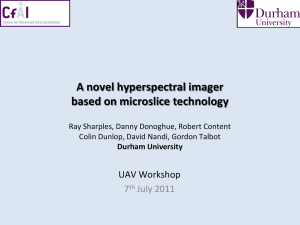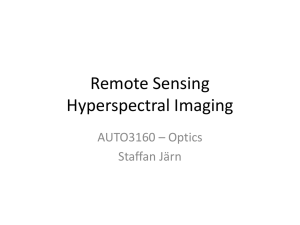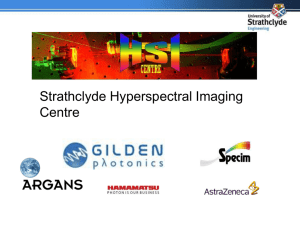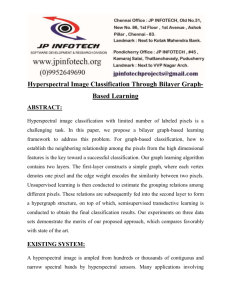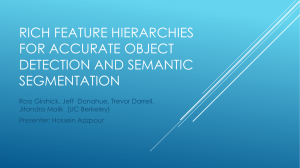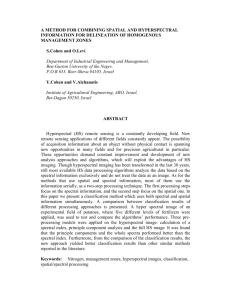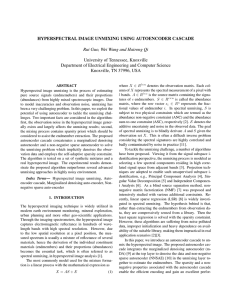SVM – Spectral Unmixing
advertisement
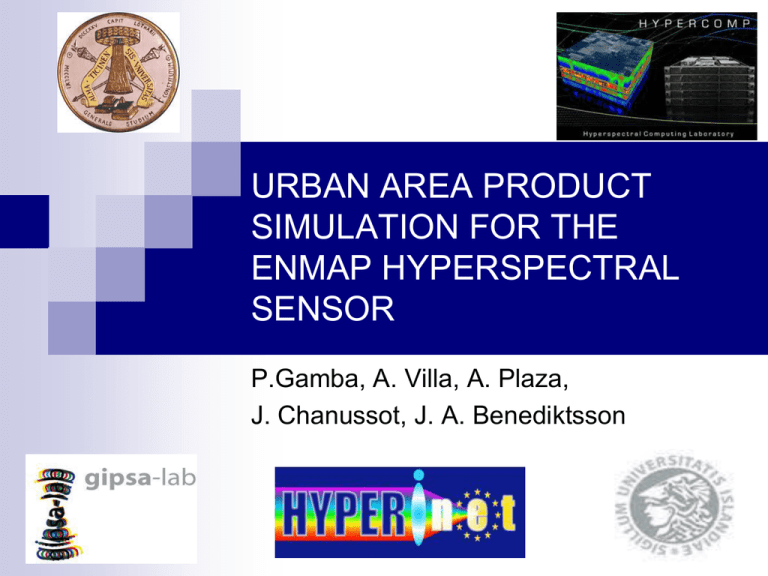
URBAN AREA PRODUCT SIMULATION FOR THE ENMAP HYPERSPECTRAL SENSOR P.Gamba, A. Villa, A. Plaza, J. Chanussot, J. A. Benediktsson OUTLINE 1) 2) 3) 4) Introduction The EnMap sensor Experimental test Conclusions and perspectives INTRODUCTION Urban remote sensing is a crucial task : • • • Monitoring cities development Infrastructure extraction Land cover mapping Satellites provide cheap and timely data Main challenges : • • Urban land cover classes not well distinct Heterogeneous areas lead to mixed pixels Can hyperspectral data be helpul for such a task? INTRODUCTION Can hyperspectral data be helpul for urban monitoring? • • Pro: very detailed spectral information of the scene Con: tradeoff between spectral and spatial resolution (~tens of meters) A number of hyperspectral missions already planned: • • • PRISMA – ASI, 2014 (spatial res: 30 m) EnMap – DLR, 2014 (spatial res: 30 m) Hyper-J (JAXA) and HyspIRI (NASA) in the next future.. Need to assess the effectiveness of hyperspectral data for urban monitoring! AIM OF THE WORK • Preliminary investigation of hyperspectral sensors potentialities: - Can urban structures be monitored with hyperspectral sensors? - Is the rich spectral information of hyperspectral data useful for such a task? • Two main issues addressed: 1) Creation of realistic urban scenes by considering EnMap PSF 2) Comparison with classical and advanced methods OUTLINE 1) 2) 3) 4) Introduction The EnMap sensor Experimental test Conclusions and perspectives EnMap mission Dedicated imaging pushbroom hyperspectral sensor mainly based on modified existing or pre-developed technology Broad spectral range from 420 nm to 1000 nm (VNIR) and from 900 nm to 2450 nm (SWIR) with high radiometric resolution and stability in both spectral ranges Swath width 30km at high spatial resolution of 30 m x 30 m and off-nadir (30°) pointing feature for fast target revisit (4 days) Sufficient on-board memory to acquire 1.000 km swath length per orbit and a total of 5.000 km per day. S. Kaiser , B. Sang , J. Schubert , S. Hofer and T. Stuffler: "Compact prism spectrometer of pushbroom type for hyperspectral imaging", Proc. SPIE Conf. Imaging Spectrometry XIII, vol. 7100, p.710001, 2008. SYNTHETIC REALISTIC IMAGES 1) Create realistic hyperspectral images by downscaling the spatial resolution according to the EnMap PSF EnMap PSF (900 nm) Spatial resolution degradation Original image Low resolution image CLASSIFICATION COMPARISON 2) Evaluate the performances of traditional methods and sub-pixel techniques in terms of land cover classification SVM SVM-SU1 Classification map Classification map at finer resolution Low resolution image 1. Villa et al., Spectral Unmixing to obtain classification maps at a finer resolution, Journal of Selected Topics in Signal Processing, 2011 SVM - SU SVM – Spectral Unmixing(*): (*)A. 1) Probabilistic SVM determines which pixels can be considered as pure (if prob > treshold) 2) Spectral unmixing is used to retrieve class abundances within mixed pixels 3) Final spatial regularization Villa, J. Chanussot, J.A. Benediktsson and C. Jutten., Spectral Unmixing to obtain classification maps at a finer resolution, Journal of Selected Topics in Signal Processing, vol. 5, n. 3, May 2011 SVM - SU SVM – Spectral Unmixing: 1) Probabilistic SVM determines which pixels can be considered as pure (if prob > treshold) 2) Spectral unmixing is used to retrieve class abundances within mixed pixels and to fill “upsampled” sub-pixels 3) Final spatial regularization SVM - SU SVM – Spectral Unmixing: 1) Probabilistic SVM determines which pixels can be considered as pure (if prob > threshold) 2) Spectral unmixing is used to retrieve class abundances within mixed pixels and to fill “upsampled” sub-pixels 3) Final spatial regularization is performed (Cost function to be minimized: total perimeter of the connected areas ) The results is a thematic map at a finer resolution useful to assess possibilities offered by HSI at low-medium spatial resolution. OUTLINE 1) 2) 3) 4) Introduction The EnMap sensor Experimental test Conclusions and perspectives DATA SET • ROSIS Center data set: • • • • 1096 x 712 pixels, 102 spectral bands Spatial resolution: 1.3 meters Spatial resolution decreased of a factor 3 and 5 Classification with SVM and SVM-SU, 100 samples per class. EXPERIMENTS Reference data SVM SVM-SU ROSIS Center (3x downscale) OA (%) Δ (%) 98.11 79.56 81.89 - 19.55 - 16.22 ROSIS Center (5x downscale) OA (%) Δ (%) 98.11 70.97 74.32 - 27.14 - 23.79 THEMATIC MAPS SVM on original HR data (ground truth) SVM on LR data Finer Classification 70.97% 74.32% THEMATIC MAPS SVM on original HR data (ground truth) SVM on LR data Finer Classification 70.97% 74.32% EXPERIMENTS Preliminary conclusions -- Even slight spatial resolution degradation leads to a significant classification accuracy decrease -- Sub-pixel information of HSI is helpful to improve classification accuracy -- Potentialities of hyperspectral data depend on the desired application OUTLINE 1) 2) 3) 4) Introduction The EnMap sensor Experimental test Conclusions and perspectives CONCLUSIONS Conclusions -- Low spatial resolution is a major challenge in urban environment → Hard to perform urban monitoring with hyperspectral sensors -- Additional spectral information useful if properly exploited → Need for advanced techniques to study sub-pixel information Perspectives - Consider more realistic models (more PSFs, geometric distortions..) - Investigate lower spatial resolution (comparable to HSI) - Further investigations of the possibilities offered by sub-pixel methods
